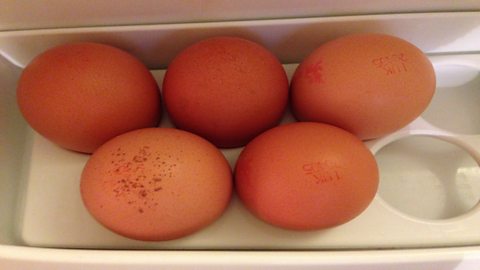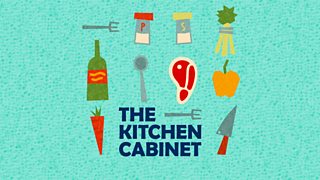Flipping fantastic facts about pancakes
It’s time to polish up your frying pan, dust off your apron and whip out your whisk. Shrove Tuesday means one thing: pancakes. If you want to make your batter even better to ensure none of your pancakes fall flat, follow our tips for making the perfect pancake.
To celebrate the day when we get through more eggs, lemon and sugar than any other, we’ve also tossed together some delicious facts all about our favourite, flat, fried cake.

-
![]()
The Food Programme
Investigating every aspect of the food we eat.
How to make sure your first pancake isn't a flop
It's true - the first pancake is always the worst.
Have you noticed that the first pancake you cook is always inferior to the ones that follow? Well it’s not just you! It’s true – the first pancake is always the worst. There are two reasons for this. Firstly, the pan needs to be hot across its whole surface – an even heat is the secret to a good pancake. (To test the pan is hot enough, sprinkle water onto it. If it sizzles, you’ve got the green light.) Secondly, you need to ease back on the butter. Too much results in pools of fat, causing the batter to fry in patches. Less oil allows a pancake to bake to a golden brown, rather than deep fry.
Room temperature batter beats cold batter
Let your batter get to room temperature before you ladle it into the pan. Cold batter will quickly reduce the temperature of the frying pan – and we all know what that means (see above).
Looking for a lighter pancake? Let it rest
You’ve probably been advised to let your batter rest for ten minutes before you start cooking. But why? Basically, this allows the wet and dry ingredients to properly meld. It also allows the gluten you created when mixing everything to relax, and the starch in the mixture to swell. All this helps to create a lighter, less rubbery pancake.

Did you know?
1. Pancakes have been around since the Stone Age
Evidence of pancakes were found in the stomach of human remains dating back 5,300 years. Examination of Otzi the Iceman, whose body was discovered in the Italian Alps in 1991, revealed that his last meals included red deer, ibex and ground einkorn wheat. The traces of charcoal he had eaten along with the grain suggest that it was in the form of a pancake, cooked over coals.
-
![]()
The Kitchen Cabinet
Jay Rayner hosts a culinary panel show packed full of tasty titbits that might change the way we think about food, cooking and eating.
2. It was the Romans who invented a more contemporary pancake
Otzi may have been munching on pancake-like flatbreads, but it was likely the Ancient Romans in the 1st century CE who first got their teeth into sweet pancakes, much like the ones we eat today. Alita Dolcia (which means “another sweet” in Latin), was concocted of milk, flour, egg, and spices. These pancakes were sold hot on street corners.
3. The worldβs largest pancake was over 15 metres across
Measuring over 15 metres in diameter and 2.5 centimetres deep, the world's largest pancake was made in Rochdale, Greater Manchester in 1994 by the Co-operative Union Ltd. In order to qualify for the record, the giant pancake even had to be flipped. This was achieved with the help of cranes!
-
![]()
ΒιΆΉΤΌΕΔ Food: Savoury pancake recipes
Not quite convinced by sweet pancakes or want to mix it up? Try out some savoury fillings and don't be afraid to experiment.

4. Thereβs a pancake called the Dutch baby
A Dutch Baby is a sweet, souffléd pancake, which is baked in a pan in the oven, rather than fried on a hob. For fans of a traditional roast, it looks much like a large Yorkshire pudding. Don’t be fooled by the name: the Dutch baby originated in the United States in the early 1900s, and has nothing to do with the Netherlands. Although the first people to make it were probably Dutch pilgrims.
5. If you fancy peanuts in your pancake, head to Southeast Asia
Apam Balik, which means “turnover pancake”, is a folded pancake that’s popular street fare in Malaysia, Singapore and Indonesia. These rice flour pancakes are normally stuffed with a sugary, buttery, peanut filling. It is thought to have originated in China in the 1800s when one military leader, General Tso, had the idea of feeding his soldiers using locally-sourced cane sugar and peanuts.
6. The French hold a coin in one hand when they flip
Every year on the 2nd February, the French celebrate La Chandeleur (or Jour des Crêpes) – a day when everybody cooks crêpes, a type of very thin pancake. As if flipping pancakes wasn’t hard enough, tradition demands they hold a coin in the other hand while the pancake is turned. If the crêpe is flipped over on the first attempt, it’s thought there will be enough money for the family for the year to come.

The best way to store and preserve eggs
Tim Hayward explains the science behind the best methods for storing eggs.

7. CrΓͺpe Suzette is the result of an accidental kitchen fire
If you like your pancake preparation to involve a bit of a performance, then Crêpes Suzette is the dish for you. This French pancake is served hot with a sauce of sugar, butter, orange juice and booze (usually Grand Marnier), which is then lit. The fun, flambé element is often performed in full view of the restaurant guests. Now one of the most famous pancake dishes in the world, it was actually created by mistake when a fourteen-year-old assistant waiter in Paris was preparing a dessert for the Prince of Wales (our future King Edward VII) and accidentally set fire to it.
More from Radio 4
-
![]()
Can comfort foods really make you feel better?
Yes they can, says Sheila Dillon.
-
![]()
Real tasty: Iconic food moments in fim
A smorgasbord of memorable moments the combine fine dining with unforgettable films.
-
![]()
Are carbs your friend or foe?
We attempt to bust some of the myths surrounding this hotly debated topic.
-
![]()
How to make Easter mean more
What are the positive messages we can all take from these Easter emblems?







